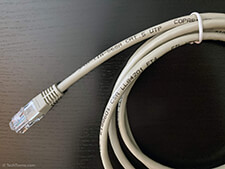Cat 5
Cat 5 (short for "Category 5") is a type of Ethernet cable. It supports data transfer rates of up to 100 Mbps, or 12.5 megabytes per second. Cat 5 cables operate at a 100 MHz frequency and can extend up to 100 meters between connected devices.
Each Cat 5 cable has eight internal wires, or four "twisted pairs." These pairs, which are color-coded, may be wired two different ways into the RJ45 connector. A Cat 5 cable with the same wiring on each end is a "patch cable," while one that is wired differently on each end is a "crossover cable."
Category 5 Ethernet cables were commonly used for creating local area networks in the late 1990s and early 2000s. Since they supported 100 Mbps transfer rates, they were sufficient for 100BASE-T "Fast Ethernet" networks. In 2001, Cat 5e cables, which support 1000BASE-T (Gigabit Ethernet), began to replace Cat 5 cables. Today, most wired networks use Cat 5e cables and above. The low maximum data transfer rate of Cat 5 would create a bottleneck in most modern networks.
NOTE: "Cat 5" is shorthand for "category 5." Since there is no standard abbreviation, "Cat5" and "Cat-5" are also acceptable.
 Test Your Knowledge
Test Your Knowledge